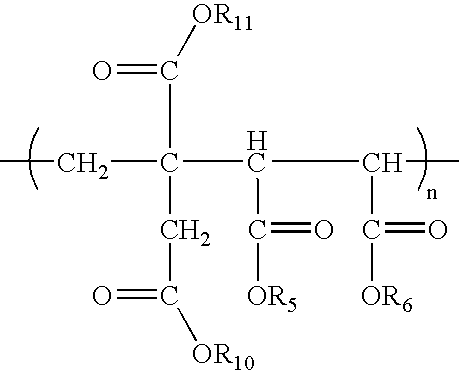Anionic polymers composed of dicarboxylic acids and uses thereof
a technology of dicarboxylic acid and anionic polymer, which is applied in the field of anionic polymers, can solve the problems of significant use limitation, inability to biodegrade, and reducing utility
- Summary
- Abstract
- Description
- Claims
- Application Information
AI Technical Summary
Benefits of technology
Problems solved by technology
Method used
Image
Examples
example 2
[0040] This reaction was carried out in equipment similar to that used in Example 1 above. The following procedure was followed: 847 g purified water was placed into the reactor. Next, 172 g itaconic acid and 130 g maleic anhydride were added with vigorous stirring. This mixture was heated to about 85-90 EC, at which temperature this mixture exists as a clear solution. When the mixture reached the desired temperature, 15 g of potassium persulfate was added to the solution. The reaction mixture was allowed to stir for 3 hours, and a second portion of persulfate, equal to the first, was added, and allowed to react for a further 3 hours. Product was isolated in the same manner as described for Example 1. A schematic representation of this reaction is shown below. 7
example 3
[0041] The procedure of Example 2 was followed, but the product was not isolated. Instead, it was diluted with water to give a 10% w / w solution. Then, 6.62 g ZnO was added to 200 g of this solution. The oxide dissolved in the liquid with stirring. This solution was then dried to a white highly water-soluble powder.
example 4
[0042] The procedure of Example 2 was followed, but the product was not isolated. Instead, it was diluted with water to give a 30% w / w solution. 6.66 g CuO was then added to 260 g of this solution. The oxide dissolved in the liquid with stirring and heating to about 60 degrees C. This solution was then dried to a green-colored highly water-soluble powder.
PUM
| Property | Measurement | Unit |
|---|---|---|
| Time | aaaaa | aaaaa |
| Time | aaaaa | aaaaa |
| Electric charge | aaaaa | aaaaa |
Abstract
Description
Claims
Application Information
 Login to View More
Login to View More - R&D
- Intellectual Property
- Life Sciences
- Materials
- Tech Scout
- Unparalleled Data Quality
- Higher Quality Content
- 60% Fewer Hallucinations
Browse by: Latest US Patents, China's latest patents, Technical Efficacy Thesaurus, Application Domain, Technology Topic, Popular Technical Reports.
© 2025 PatSnap. All rights reserved.Legal|Privacy policy|Modern Slavery Act Transparency Statement|Sitemap|About US| Contact US: help@patsnap.com



